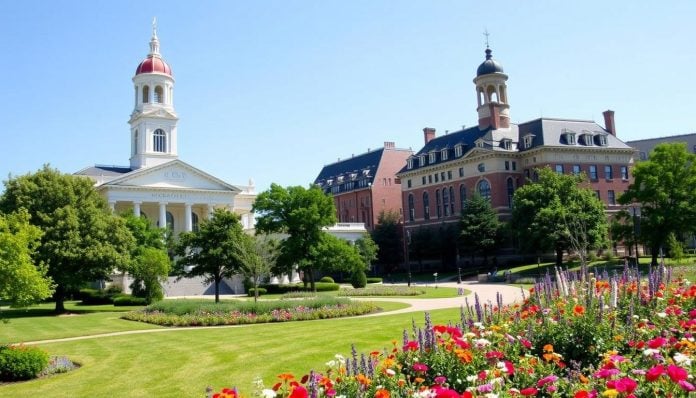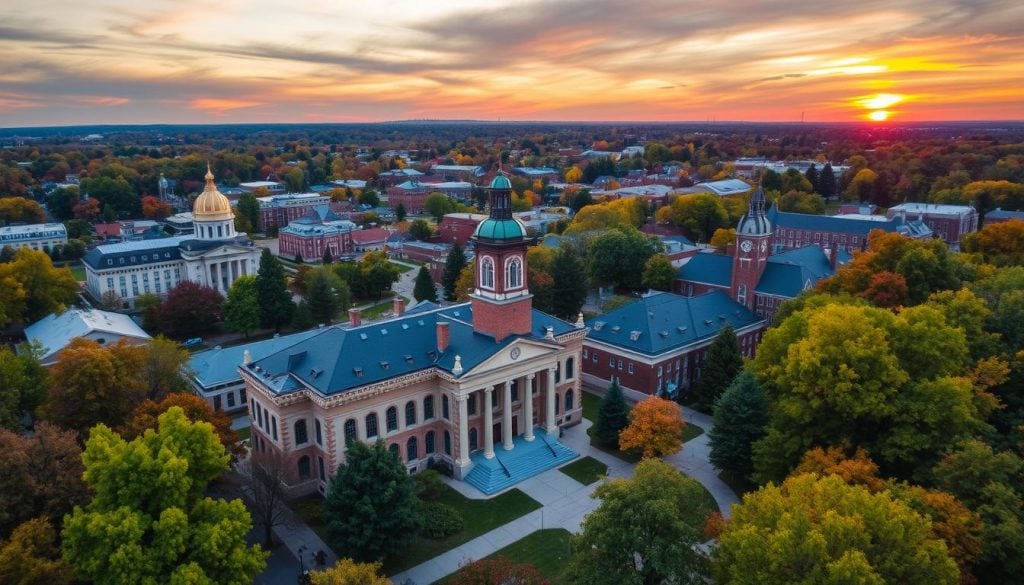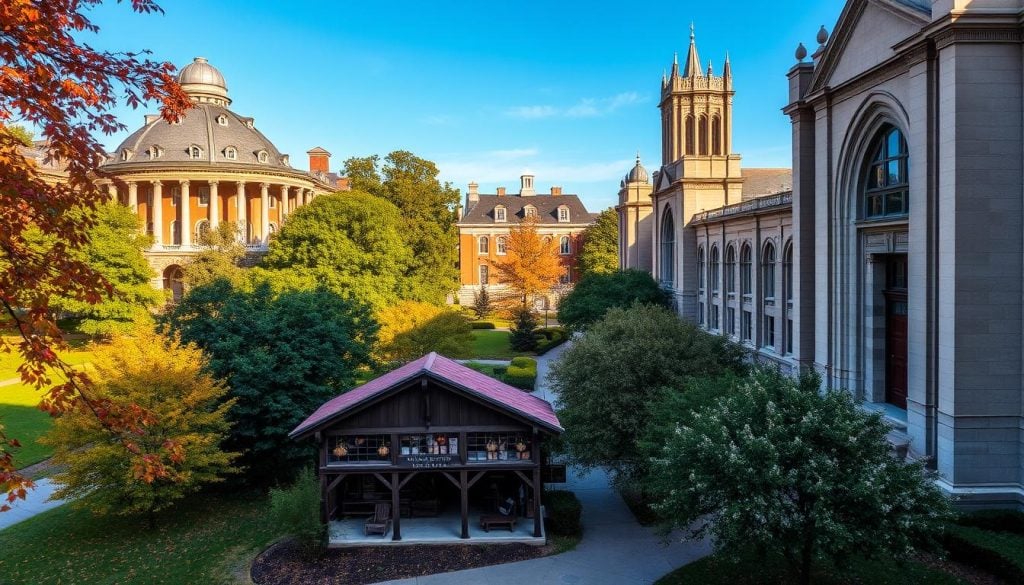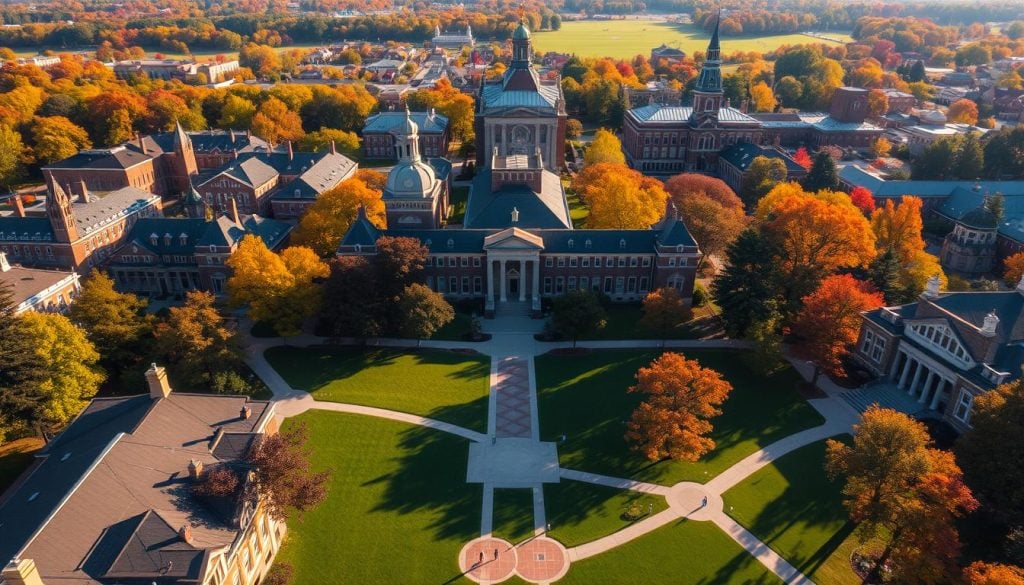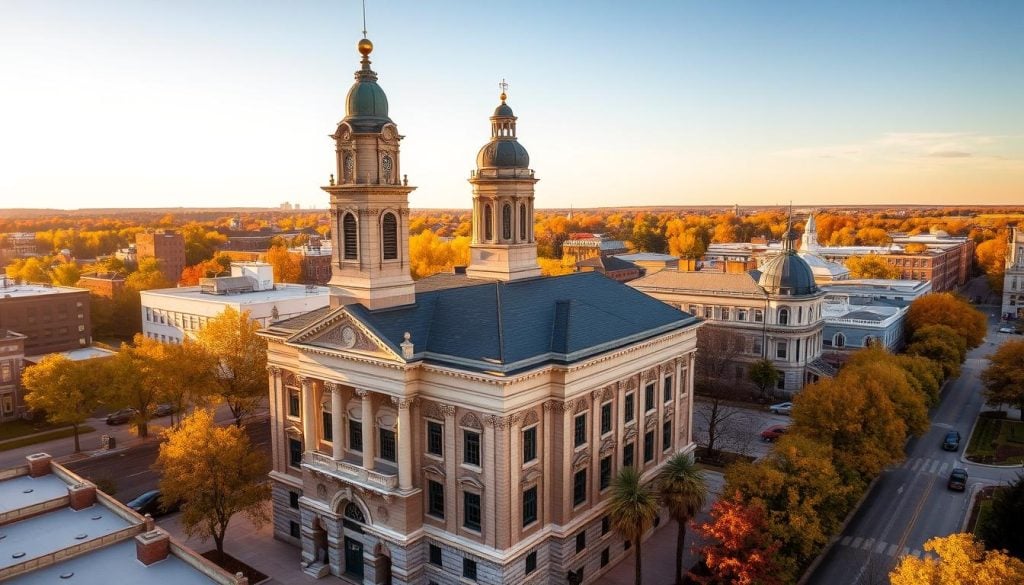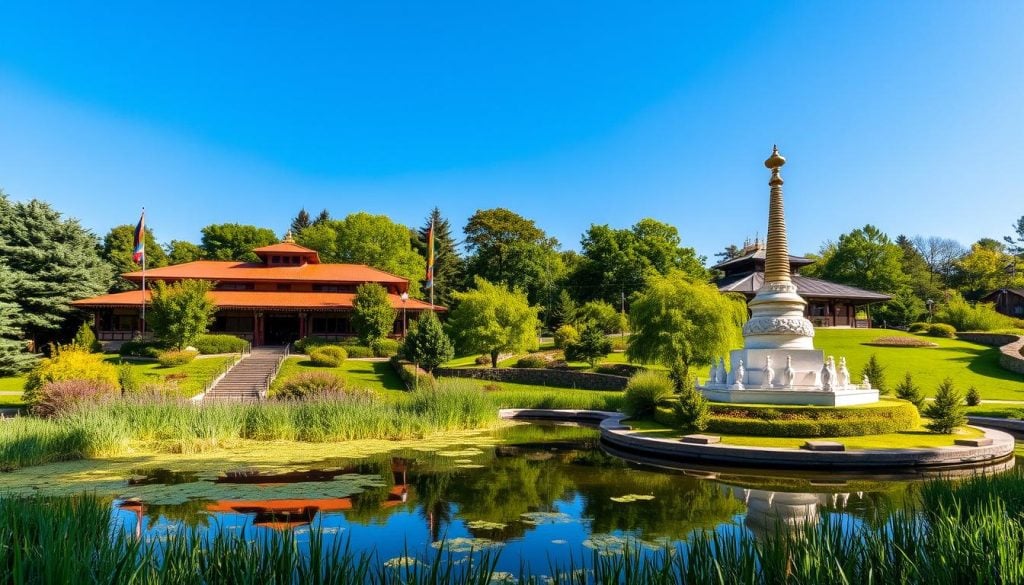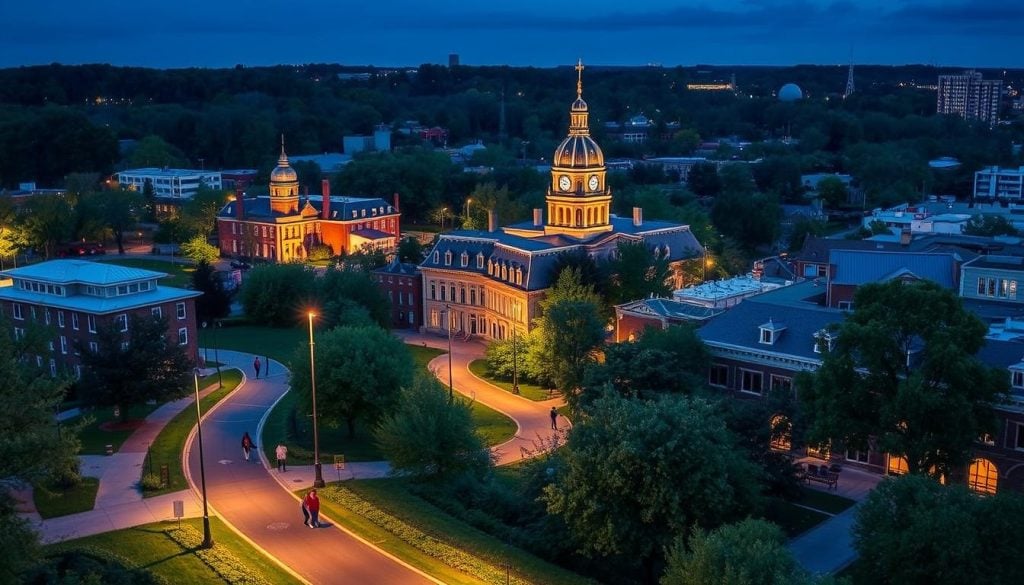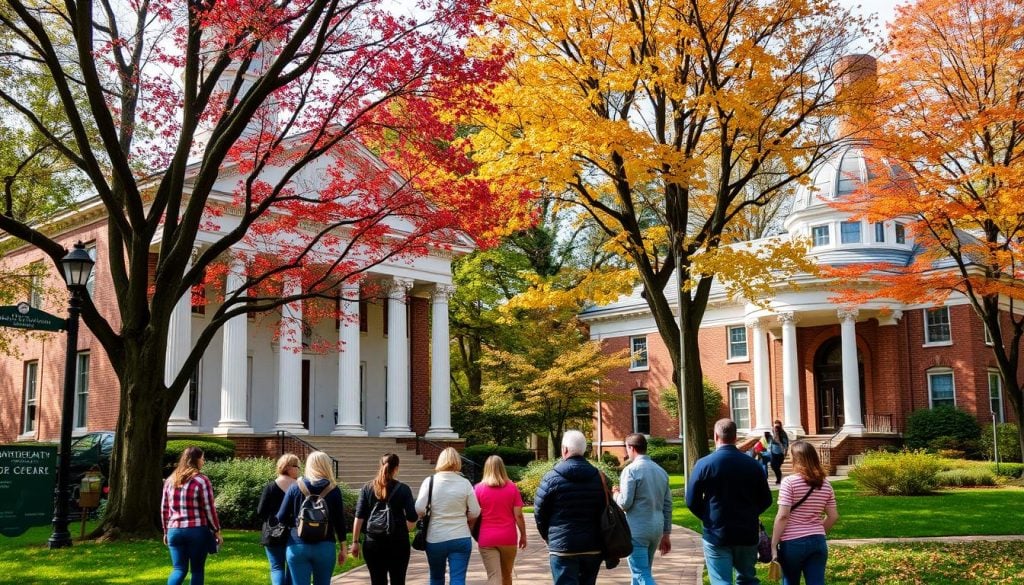Ever wondered about the hidden stories in Bloomington’s historic landmarks? This college town is more than just a place for learning. It’s full of cultural heritage waiting to be discovered. From its beginnings in the limestone industry to its famous Indiana University, exploring Bloomington’s history is like stepping back in time.
This guide will take you to the top historical spots in Bloomington. You’ll see beautiful buildings and important cultural sites. These landmarks are not just buildings; they tell the story of a community shaped by history.
Introduction to Bloomington’s Rich History
Bloomington has a fascinating history that mirrors Indiana’s growth. To dive into exploring Bloomington’s history, we must look at its limestone industry and the start of Indiana University in 1820. This event was a big step in education, being the first state college west of the Allegheny Mountains. The city’s history is seen in its beautiful buildings, lively museums, and cultural events that bring people together.
Among the Bloomington historic landmarks, you’ll find many buildings that share stories of the past. These landmarks not only show off the architecture of their times but also help us understand how the city grew. Whether you’re walking through historic areas or checking out museums, each place gives you a special look into Bloomington’s heart.
What Historical Sites Are a Must-See in Bloomington?
Bloomington is filled with historical sites that show its deep cultural roots. These places let you see how the city has grown and changed over time. They are key to understanding Bloomington’s history and spirit.
Overview of Key Historical Attractions
Some top historical spots in Bloomington are:
- Indiana University: Known for its stunning campus and historical importance. It’s a center for culture and learning, playing a big role in the city’s identity.
- Wylie House Museum: Offers a peek into life in the 1800s, showing how the original owners lived. You can take guided tours to learn more about local history.
- Monroe County Courthouse: A beautiful example of Beaux-Arts architecture, it reflects the area’s history and community events.
Importance of Historical Sites in Understanding Local Culture
Exploring these historical sites in Bloomington helps you appreciate the local culture more. You connect with the stories and experiences kept alive in these places. This deepens your understanding of the community’s shared past, making your visit more meaningful.
| Historical Site | Significance | Visitor Experience |
|---|---|---|
| Indiana University | Educational Institution with Historic Buildings | Walking Tours, Cultural Events |
| Wylie House Museum | 19th Century Historic Home | Guided Tours, Exhibits |
| Monroe County Courthouse | Architectural Landmark | Public Tours, Community Events |
Indiana University: A Historical Landmark
Indiana University is a key historical spot in Bloomington. It gives visitors a deep look into Indiana’s academic history. The campus is known for its beautiful Georgian-style buildings made from local limestone. This makes it a favorite spot for those interested in history.
Architectural Significance of Indiana University
The campus’s architecture shows the area’s history and culture. You can see buildings in the Georgian style, showing off the era’s craftsmanship. These designs make the campus a beautiful place for a history tour. They also show the university’s long dedication to education and community.
Campus Museums and Cultural Heritage
Indiana University has museums like the Eskenazi Museum of Art. It has a huge collection from different cultures and art styles. This museum lets you explore the university’s cultural heritage and see many beautiful works.
As a top spot in Bloomington, the campus museums offer deep experiences. They make sure visitors learn a lot about history and today’s culture.
Wylie House Museum: A Glimpse into the Past
The Wylie House Museum is a key spot in Bloomington, offering a peek into 19th-century life. Built in 1835, it was the home of Andrew Wylie, Indiana University’s first president. This museum keeps the era’s architecture alive and tells the story of its residents, deepening your knowledge of Bloomington’s history.
History of the Wylie House and Its Architect
The Wylie House was built with a focus on both functionality and tradition. It shows the style of the early 19th century with its beautiful brickwork and details. Its importance comes from being linked to Andrew Wylie, a key figure in Indiana University’s founding. His work shaped the area’s education, making the Wylie House a symbol of this legacy.
Guided Tours and Educational Opportunities
At the Wylie House Museum, you get more than a look at the past; you get a guided tour that makes history come alive. Staff members share stories of the past and the lives of its former residents. You’ll see the elegant heirloom gardens, kept true to the era’s style. The museum also offers programs for students and adults, letting you explore Bloomington’s history in depth. This makes the Wylie House a must-see for those interested in historical places in Bloomington.
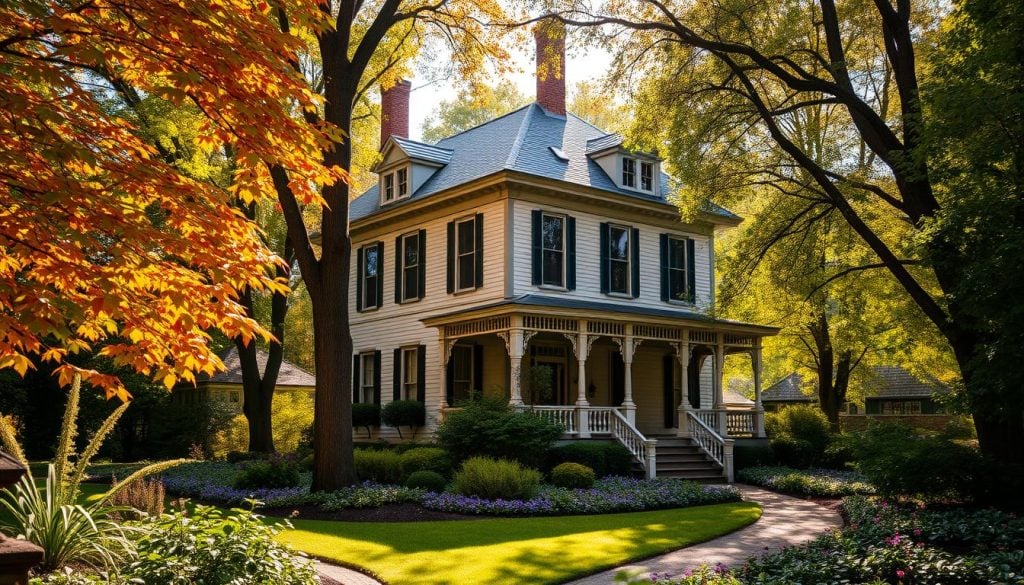
| Feature | Description |
|---|---|
| Year Built | 1835 |
| Owner | Andrew Wylie |
| Architectural Style | 19th Century |
| Guided Tours | Available to the public |
| Educational Programs | Workshops and lectures |
Monroe County Courthouse: An Architectural Gem
The Monroe County Courthouse is a key example of Beaux-Arts architecture in the area. It draws in those who love architecture and tells the story of Bloomington’s history. Its beauty shows the city’s deep history and the important events that happened there.
Beaux-Arts Architecture and Historical Importance
This courthouse is a top spot in Bloomington for history lovers. It features detailed designs typical of the Beaux-Arts style. You can see grand columns, a stunning dome, and beautiful decorations. During holiday events, it’s lit up, making the area festive and attracting both locals and visitors.
Community Events and Tours at the Courthouse
The courthouse is a place where the community comes together. It hosts events that unite people. You can join guided tours that focus on its architecture and its role in Bloomington’s life. These tours let you see the building and learn about the city’s ongoing story, making it a key landmark.
Buskirk-Chumley Theater: A Cultural Hub
The Buskirk-Chumley Theater is a key spot in Bloomington for culture. It has a long history, offering a mix of performances that connect you to the area’s arts. This theater has changed over time, showing the community’s love for the arts.
Historical Overview of the Theater
It started as a silent film theater, but now it’s a place with a mix of old charm and modern touches. This shows how much Bloomington values arts and culture. Walking in, you feel like you’re stepping back in time, surrounded by the stories of many performances.
Current Events and Community Engagement
Today, the theater hosts many events, like concerts and plays. These events draw people from all walks of life, making the local arts scene richer. Going to the Buskirk-Chumley Theater is a great way to see Bloomington’s cultural heart. It brings people together and helps them appreciate the arts more.
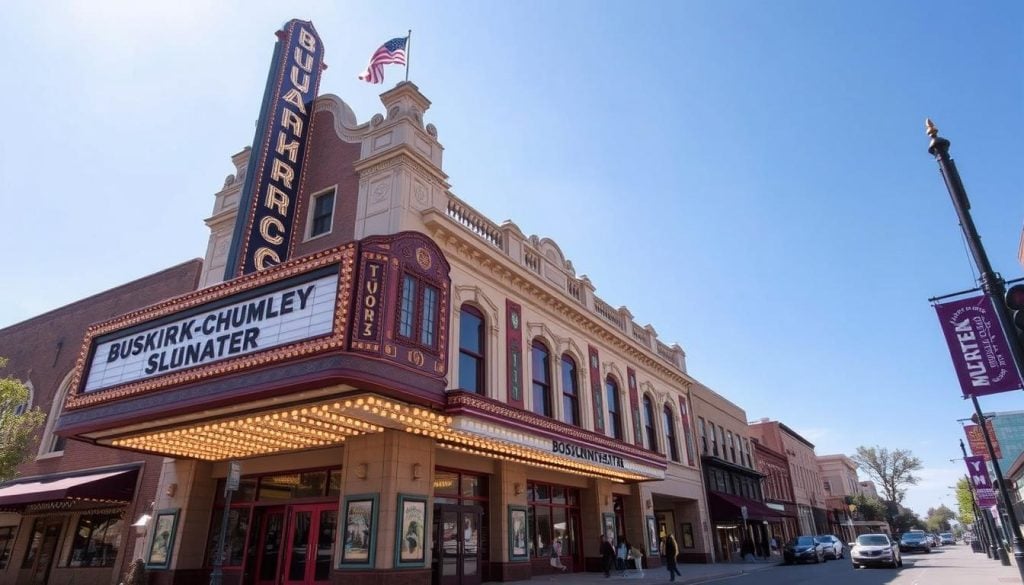
| Event Type | Description | Frequency |
|---|---|---|
| Concerts | Various local and national artists perform. | Regularly scheduled |
| Theater Productions | Including local theater groups and touring companies. | Seasonally |
| Film Screenings | Classic and contemporary films shown to the public. | Weekly |
| Community Events | Workshops, lectures, and special programs. | Varies |
Tibetan Mongolian Buddhist Cultural Center
The Tibetan Mongolian Buddhist Cultural Center is a top spot in Bloomington. It shows off Tibetan culture with its beautiful buildings and calm surroundings. You can see amazing statues and art that honor Buddhist traditions. It’s perfect for those wanting to learn about different cultures.
Art and Architecture of the Center
The center’s design mirrors traditional Tibetan style, with bright colors and detailed carvings. The peaceful vibe lets you dive into a world of spirituality and learning. Highlights include:
- Intricate Buddhist statues
- Beautiful gardens that promote peace and reflection
- Distinct architectural elements that showcase Tibetan craftsmanship
Guided Tours and Cultural Events
The center offers guided tours that share its deep history. You can join workshops and cultural events too. These activities help you meet locals and learn about Buddhist ways. Key events are:
- Educational workshops on Buddhist teachings
- Cultural festivals celebrating Tibetan heritage
- Guided tours that explore the history and significance of the center
B-Line Trail: An Urban Historical Walk
The B-Line Trail in Bloomington is a mix of city views and history. It stretches 3.1 miles, linking important spots and showing off landmarks that tell the city’s story. Walking or biking here, you’ll see markers that share stories of Bloomington’s past.
The trail starts at Adams Street and ends at Country Club Drive. It invites everyone to enjoy the city’s lively vibe. You’ll breathe in fresh air and see sights that show Bloomington’s growth.
Walking the B-Line Trail is good for your health and your mind. It lets you see the historical importance of the places you pass. You’ll find moments where history and nature meet. It’s perfect for relaxing walks or energetic bike rides.
| Landmark | Historical Significance | Nearby Features |
|---|---|---|
| Adams Street | Starting point of the trail, rich in architectural history | Parks and local cafes |
| Bloomington Community Arts Center | A hub for local artists and historical exhibitions | Art installations and galleries |
| Buskirk-Chumley Theater | Historic theater showcasing cultural performances | Beautifully landscaped areas ideal for gatherings |
| Country Club Drive | End point linking to the city’s modern amenities | Shopping and dining options |
The B-Line Trail is more than just a place to walk or bike. It connects you to Bloomington’s rich history. Every visit can reveal new stories, making it a great spot for both locals and visitors to explore the city’s past and present.
Exploring Bloomington’s History Through Tours
Starting a Bloomington history tour opens up a world of stories. These tours give you a deep look into the city’s heritage. They’re a key part of exploring Bloomington’s history.
These tours take you to the most important historical spots in Bloomington. They make your visit more meaningful by sharing stories and connecting you to the past.
Benefits of Guided History Tours in Bloomington
Guided tours offer many benefits. You get to hear from experts who know a lot about the places you visit. This makes your experience richer and more enjoyable.
Here are some advantages:
- Expert Narration: Guides share deep insights that make the sites more interesting.
- Cultural Engagement: You learn about local customs tied to the historical sites.
- Interactive Experience: You can talk with others who love history as much as you do.
Popular History Tour Experiences
Many tours focus on Bloomington’s history, each with its own special theme. Here are some popular ones:
- Indiana University tours show off its beautiful buildings and important moments in history.
- The Wylie House Museum lets you see how people lived in the past.
- Community-led walking tours reveal hidden stories of the city’s history.
Conclusion
Bloomington, Indiana, is a city full of history. It offers a peek into its cultural past. If you’re curious about historical sites in Bloomington, start with Indiana University. It’s not just a school but also a symbol of architectural beauty.
The Wylie House Museum is another must-see. It lets you step back in time and feel the history around you.
Every historical site in Bloomington tells a story. The Monroe County Courthouse and the Buskirk-Chumley Theater are just a couple of examples. They show what makes Bloomington unique. Visiting these places makes you appreciate the city’s culture more.
Seeing the historical sites in Bloomington is an enriching journey. As you walk through the city, you’ll discover stories and experiences that shape its identity. Make sure to explore Bloomington’s history and its cultural importance.

































